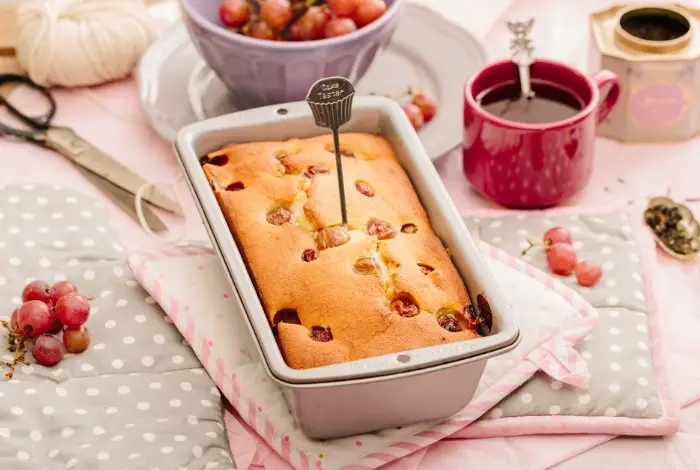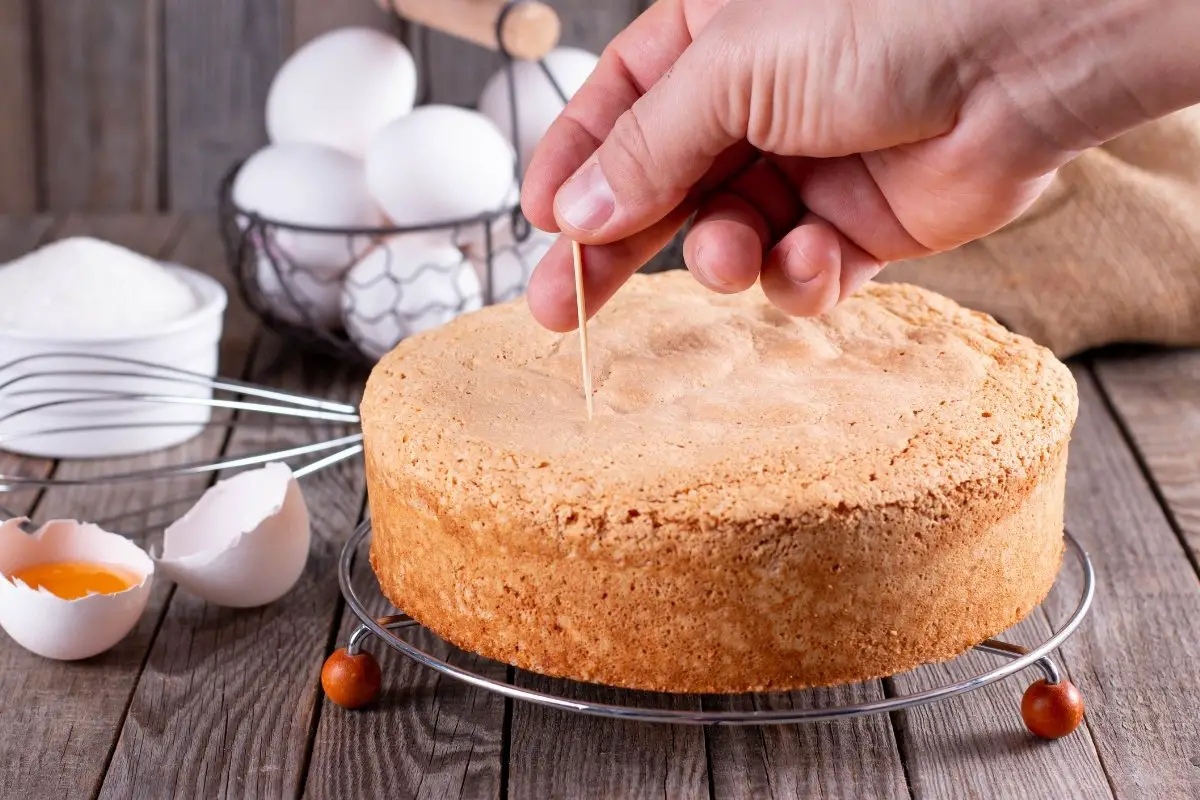Last Updated on March 18, 2023
Why is my cake wet in the middle? Is it because I accidentally undercooked it? What are the most effective solutions when this happens? If the cake is wet in the middle, the main reason is that you may not have baked it long enough. That is why it is best to adjust the temperature and cooking time. In addition to that, lessen the heat, however, leave the cake in the conventional oven longer.
Why is My Cake Wet in the Middle?
Usually, if the oven does not heat up evenly, then your cake is moist in the middle because it cannot cook the cake evenly. Another reason is the improper usage of baking powder. For instance, you are using too much baking powder in your recipe. Likewise, utilizing old baking powder causes the cake to stay moist in the middle.

Moreover, another reason could be using the wrong baking pan. It would help if you used a baking pan with the appropriate size corresponding to the one mentioned in the recipe. In addition to that, most individuals bake their cakes using aluminum pans. And the most often mistake is that they use a smaller and deeper aluminum pan. Taking this into account, it is not appropriate for the cooking time mentioned in the recipe.
Find more delicious recipes here: Delicious Peach Galette using Frozen Peaches and Amazingly Chocolatey Zucchini Cake Recipe
What can I do to fix my Undercooked Cake?
In most cases, if the cake is wet in the middle, then you have an undercooked cake. Though, do not worry because you can still fix it. As soon as you have taken the cake out of the oven and realized that it requires more time to cook, immediately put it back into the conventional oven for ten to fifteen minutes. With that, make sure to check the cake after every five minutes if there are any changes. Afterward, cover the cake with aluminum foil if you have sliced a portion of it out or if it is not necessary to have the top brown even more.
Wet in the Middle
It is because you are using the wrong pan size for the recipe, setting it at low oven temperature, and incomplete cooking time. You can solve it by covering it with aluminum foil to trap the heat inside and cook it further. Then, cook it for approximately ten to fifteen minutes. Remember, check it halfway through the cooking time. In addition to that, you can utilize the toothpick test. If a toothpick is unavailable, then you can use a skewer instead.
Undercooked Bottom of the Cake
The most usual reason for this is putting it in the wrong spot in the oven. Likewise, unequal heating of the oven. To fix this:
- Place the undercooked cake in the middle of the range.
- Check the heat and adjust it to low heat to cook it further.
- Cover it with aluminum foil to avoid overcooking the top while the bottom is cooking.
- Remember, cook with low heat only.
Alternatively, you can switch off the upper heat of the conventional oven.
Entirely Undercooked Cake
It is due to incomplete cooking time and low oven temperature. As a solution, place the undercooked cake back in the oven. Let it cook for around ten to fifteen minutes with or without foil. Keep in mind that you should be checking it every five minutes to prevent overcooking.
What Does Undercooked Cake Taste Like?
Lots of people like to eat undercooked cake. Growing up, I even remember licking the bowl clean when making cakes. However, this is not a good idea!
When a cake is undercooked, the flavors will no doubt be delicious as it simply tastes of cake (and whichever flavorings you’ve used). However, the texture will not be quite what you’re used to. As you come to the center of an undercooked cake, it will likely be stodgy, wet, and dense.
While the taste of the cake will still likely be delicious, it is simply not worth the risk. To avoid undercooking your cake in the future, you can keep a watchful eye out for the following problems: it may not have been left to cook long enough, the oven may not be at the correct temperature, the oven may not have been preheated, the cake batter may not have been an even layer, and finally, you may have used the wrong type of cake pan. No matter how tempting that undercooked cake is, be sure not to taste it!
Is It OK to Eat Undercooked Puff Pastry?
In short, the answer is: no. We would highly recommend NOT eating undercooked puff pastry. Much like cake, it may seem appealing and may not taste too different from usual (except for the texture), but it is simply not safe to eat.
Undercooked pastry or any type of tough can be dangerous for your health. There are bacteria such as E.coli and salmonella that are invisible to the naked eye, but they can make you incredibly ill. When the dough is undercooked, this bacteria has not yet been killed.
Even if the undercooked puff pastry doesn’t cause any lasting problems, it can be tricky for your gut to digest and process. Because of this, you may experience GI issues such as bloating, cramping, and other stomach pains.
Can You Recook Undercooked Puff Pastry?
Of course! If you remove your puff pastry from the oven and find that it’s undercooked, there is absolutely no problem with recooking or re-baking it. To recook your undercooked pastry, try placing it back into the oven at a slightly lower temperature, as you do not want the rest of the pastry to burn. If this is unsuccessful, try removing the pieces of pastry that are undercooked and place them in the oven at a higher temperature.
If this is unsuccessful, it may be best to discard the undercooked pastry, as you can not eat it. To avoid this happening in the future, you can try to avoid doing the following things: rolling the dough too thick (this can mean it takes too long to cook, compared to the filling), setting the temperature of the oven too low (this will not allow the pastry to puff adequately and cook throughout) and finally, not using enough fat when making the puff pastry (this can alter the color of the pastry). As long as you follow these steps, you should not have to recook any of your puff pastry.
How to Avoid an Undercooked Cake?
Essentially, the best thing you can do is utilize a thermometer. It is useful for any cake; insert it into the cake, then measure, and with that, it saves you plenty of worries and hustle in making the big mistake of baking an undercooked cake. Although, make sure not to touch the baking pan.
Keep in mind that the ideal temperature for light and airy cakes does not exceed 210 degrees Fahrenheit. On the other hand, a flourless cake’s right temperature is about 205 degrees Fahrenheit.
Powlaken Meat Food Thermometer for Grill and Cooking
Moreover, do not adjust the oven to a higher setting to speed up the cooking process. Doing this is cutting it short, and as a consequence, it will burn the cake. Also, not following the cooking instructions is not a great idea. For instance, putting the oven at a lower temperature than mentioned in the recipe will result in an undercooked cake.
That is why it is essential to follow the step-by-step instructions indicated when you are baking a cake, especially if you are not familiar with it. With that, make sure to double-check the oven temperature to avoid a wet or raw cake in the middle.

Zarah is an experienced pastry chef whose creations have delighted countless customers. With a passion for baking, Zarah has developed a unique style that combines classic techniques with modern flavors. Her desserts are consistently crafted with the finest ingredients, and her attention to detail is evident in the stunning and delectable results. Zarah has a wealth of experience in the pastry kitchen, and loves to share her knowledge with others. Whether it is teaching a class or creating a custom cake for a special occasion, Zarah is committed to making sure every customer is satisfied.


